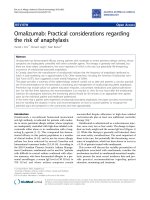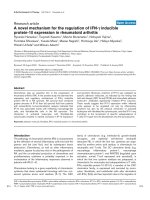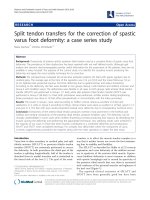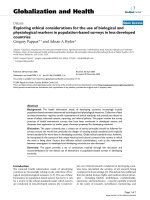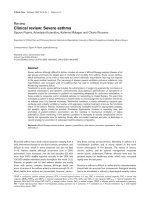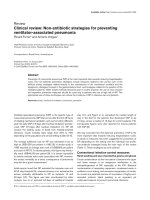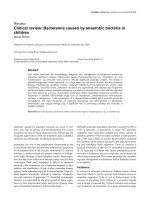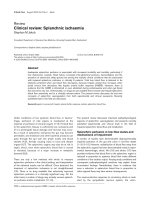Báo cáo y học: " Clinical review: Considerations for the triage of maternity care during an influenza pandemic one institution’s approach" pps
Bạn đang xem bản rút gọn của tài liệu. Xem và tải ngay bản đầy đủ của tài liệu tại đây (149.19 KB, 6 trang )
Introduction
e ongoing 2009 H1N1 infl uenza pandemic highlights
the inherent tendency of the infl uenza virus to mutate,
produce novel strains, and infect large segments of the
population in a relatively short period of time. Since the
fi rst notifi cation of the novel 2009 H1N1 strain causing
human disease in April 2009, the World Health
Organization has reported more than 300,000 confi rmed
human cases in nearly all geographic areas of the world,
and a pandemic was accordingly declared in June 2009
[1]. In addition, the Centers for Disease Control and
Prevention estimate that at least 60 million Americans
have been infected with this virus since its recognition
[2]. It is projected that ongoing infection and associated
morbidity from this strain will continue for the
foreseeable future and mass vaccination programs have
thus been undertaken. Despite the rapid and widespread
dissemination of the virus, thus far most of those infected
have suff ered mild clinical illness with the overall
mortality rate at less than 1% (approximately similar to
seasonal infl uenza) [1,2]. It is not clear, however, how the
virulence of the current strain will alter over time. In
addition, certain populations appear to be suff ering in a
dis pro portionate manner [1,2].
Previous infl uenza pandemics have repeatedly docu-
mented disproportionate morbidity and mortality among
pregnant women, with mortality rates of two to four
times the same age adult non-pregnant population [3].
Emerging data from the current pandemic validate the
vulnerable population status of pregnant women by
demonstrating an increased likelihood (fi ve to ten times)
of hospitalization and death among pregnant women [4].
Consistent with previous projections and current data,
people younger than 40 years of age, pregnant women,
and those with underlying medical illnesses are at highest
risk for severe infection from this novel strain [1-4]. At
any given time, pregnant women comprise approximately
1% of the population. However, thus far it appears that
they are responsible for approximately 5 to 10% of the
hospitalizations and deaths from H1N1 in any one locale
[4]. is approximate fi ve- to ten-fold discrepancy could
place much larger strains on hospitals that would have to
provide for an increased number of critically ill pregnant
women simultaneously converging on medical facilities
Abstract
The ongoing pandemic of 2009 H1N1 swine-origin
in uenza A has heightened the world’s attention
to the reality of in uenza pandemics and their
unpredictable nature. Currently, the 2009 H1N1
in uenza strain appears to cause mild clinical disease
for the majority of those infected. However, the risk of
severe disease from this strain or other future strains
remains an ongoing concern and is noted in speci c
patient populations. Pregnant women represent a
unique patient population that historically has been
disproportionately a ected by both seasonal and
pandemic in uenza outbreaks. Data thus far suggest
that the current 2009 H1N1 outbreak is following
this same epidemiologic tendency among pregnant
women. The increased predilection to worse clinical
outcomes among pregnant women has potential to
produce an acute demand for critical care resources
that may overwhelm supply in facilities providing
maternity care. The ability of healthcare systems to
optimize maternal-child health outcomes during an
in uenza pandemic or other biologic disaster may
therefore depend on the equitable allocation ofthese
limited resources. Triage algorithms for resource
allocation have been delineated in the general medical
population. However, no current guidance considers
the unique aspects of pregnant women and their
unborn fetuses. An approach is suggested that may
help guide facilities faced with these challenges.
© 2010 BioMed Central Ltd
Clinical review: Considerations for the triage of
maternity care during an in uenza pandemic -
oneinstitution’s approach
Richard H Beigi*
1
, Je Hodges
2
, Marie Baldisseri
2
, Dennis English
2
and the Magee-Womens Hospital Ethics Committee
REVIEW
*Correspondence:
1
Division of Reproductive Infectious Diseases, Department of Obstetrics,
Gynecology and Reproductive Sciences, Magee-Womens Hospital of the
University of Pittsburgh Medical Center, Pittsburgh, PA 15213, USA
Full list of author information is available at the end of the article
Beigi et al. Critical Care 2010, 14:225
/>© 2010 BioMed Central Ltd
and requiring critical care resources, such as ventilators.
Determination of an ethically sound triage process to
delineate use of ventilators for this population is an
important component of pandemic infl uenza prepared-
ness planning and management.
e numerous challenges posed by wide-scale infec-
tious disease epidemics such as infl uenza pandemics and
the various ethical paradigms for resource allocation
during these events have been delineated in the published
literature [5-9]. A similar document also outlines the
unique ethical challenges presented by pregnancy [10].
e medical literature also includes logistical guidance as
to how to approach this dilemma for the general medical
population but no such guidance exists for the pregnant
population that considers their unique characteristics
and needs. Such needs include, but are not limited to,
changing priorities and clinical scenarios depending on
gestational age, alteration of some of the evaluated
physiologic parameters, and consideration of another
individual, the developing fetus and/or neonate.
e overall aim of this paper is to review the medical
literature on this timely subject and delineate a prioritiza-
tion schema for ventilator (or other resources) triage and
allocation based on principles that are useful to facilities
providing obstetrical care, either in isolation (free-
standing maternity hospital) or as part of a large multi-
disciplinary acute-care facility. is document would
have the goal of benefi ting the greatest number of pros-
pective mothers and newborns, minimizing morbidity,
and improving overall survival among this unique patient
population. It is recognized that individual institutions
usually do not develop such guidelines in isolation.
However, given the unique characteristics of the pregnant
population and the recognized need for a functional
logistical approach, this document was generated.
Methods
A literature search was performed using widely available
search engines PubMed and Medline from 1966 until the
present. Keywords used included: triage, pandemics,
infl uenza, limited resources, critical-care, and pregnancy.
Listed articles were then reviewed for relevance to the
topic covered herein. When articles appeared to be rele-
vant, full citations were then accessed and reviewed in
their entirety. After review of potential applicable manu-
scripts, seven documents were identifi ed that delineated
medically specifi c logistical approaches with algorithms
to the triage of limited medical resources and those were
used as a foundation for these considerations [11-17].
After identifi cation of these relevant paradigms, the
Magee-Womens Hospital of the University of Pittsburgh
Medical Center Ethics Committee considered the issue
for 20 months from January 2008 through August 2009.
Magee-Womens Hospital is part of a large medical
system ( e University of Pittsburgh Medical Center) of
18 hospitals providing a large share of the medical
services in the southwestern Pennsylvania region.
rough out the process of quarterly meetings, numerous
issues and perspectives were considered and discussed:
members of various clerical denominations presented
religious views on relevant medical ethics, bio-ethicists
shared their expertise, physicians from multiple
specialties, nurses, and senior hospital administration
presented their respective perspectives, and members of
the lay community also shared their thoughts. A fi nal
document emerged (presented herein) with agreed upon
broad principles and specifi c algorithms that will
function for any upcoming disasters, including the
current 2009 H1N1 infl uenza pandemic. e value of the
multidisciplinary input (and their variable perspectives)
to the deliberations and the fi nal product cannot be
overemphasized. In formulating the fi nal plan it is
acknowledged that such a plan serves as a template only
and is unable to anticipate every possible situation in
advance. us, the fi nal product is presented as a guidance
document for other facilities providing mater nity care.
is document provides a foundational approach to these
challenges but also allows for ongoing situational
refi nement in the face of real disaster, its respective
specifi cs, and the appropriate facility-specifi c alterations.
Before the initiation of use of this protocol the local
public health authorities as well as the hospital system
leadership would be consulted for input. A collaborative
investigation into the existence of regional opportunities
to assist and obviate the need to use this protocol would
be undertaken. However, if no other options existed, the
protocol would go into eff ect in collaboration with both
the public health authorities and hospital system
leadership to augment the ability to assess ongoing and
future necessity of the protocol given the disease-specifi c
characteristics (such as waning local disease activity).
Foundational concepts
In order to begin conceptualization of how to triage and
allocate limited resources in a maternity setting, a
number of concepts were delineated in advance of the
acute necessity, using the venue of our hospital ethics
committee. It is believed that having these concepts
delineated in advance of a disaster will allow for a
systematic and eff ective use of the proposed schema
without having to re-consider these issues in the face of
the epidemic. e suggested concepts that were derived
and are to be used when faced with resource limitations
are listed in Table1. e listed exception of consideration
of a prospective patient’s role in society as a relevant
factor for prioritizing limited resources (being a health
care worker that delivers direct patient contact) deserves
explanation. is issue was deliberated extensively by the
Beigi et al. Critical Care 2010, 14:225
/>Page 2 of 6
committee due to its importance. is decision to
prioritize health care workers was made given the
realization of their vital role in care provision for all as
well as the recognized need to provide reassurance to
health care workers in order to maintain a functional
work force during the disaster. It is recognized that
without a sustained workforce, care provision would be
further compromised, threatening the fulfi llment of the
facility mission.
Triage schema
e foundational approach taken by the proposed
algorithm is a prioritization schema that aims to provide
the limited resources to those that have the best chance
of benefi ting from these resources. us, the grading of
prioritization status depends on the status of the patient
at the time of resource allocation. A proposed method
and frequency of reevaluation of status after receipt of
resources is addressed later in the document. However,
qualifi cation for the limited resource focuses on status at
presentation.
In order to allocate the limited resources to those most
able to benefi t, a schema that grades health status is
required. ere are two components of such a schema:
overall health status of each patient previously present
and independent of the acute disease process caused by
the current outbreak; and current acute status of the
patient graded objectively using previously validated
critical care criteria (Sequential Organ Failure Assess-
ment scoring, or SOFA score) [18]. Christian and
colleagues proposed this scoring system to the current
application, and many components of this protocol are
modeled from their proposal [13]. Note that the
physiologic parameters in the validated SOFA score are
graded for the general medical population. Where the
few pregnancy-specifi c adaptations have been made it
will be noted (lower creatinine cutoff levels and platelet
counts in women with hypertensive disorders of preg-
nancy). It is recognized that making minor modifi cations
to the specifi c criteria cutoff points of the laboratory
parameters of the SOFA scoring has not been validated
for use in pregnant women. However, these are
pregnancy-specifi c alterations that make the scoring
algorithm more relevant to this patient population given
known physiologic changes of pregnancy. Furthermore, it
is unlikely that validation of the minor changes due to
pregnancy specifi cs will be performed in a timely fashion
or that these small alterations will aff ect the validity of
the schema.
To begin to use the algorithm the fi rst required step for
each patient to assign priority is to assess patient need by
applying the proposed inclusion criteria. In order to be
eligible for receipt of a limited resource, each woman
must meet the inclusion criteria by having the following
clinical circumstances: clinically confi rmed and viable
pregnancy (defi ned in Table 1); and clear, documented
need for the limited resource (for ventilation, refractory
hypoxemia, respiratory acidosis (pH <7.25), impending
respiratory failure and/or evidence of inability to protect
the airway; for other critical care resources, clinically
apparent hypotensive shock that is unresponsive to fl uid
resuscitation and requires the use of vasoactive medica-
tions that cannot be given on regular hospital units).
It is recognized that the above parameters may appear
to set the threshold too low for intervention in pregnant
women. However, the indications for mechanical
ventilation and/or other critical care resource are nearly
identical in pregnancy when compared to non-pregnant
patients. After each woman is considered eligible for
receipt of a limited resource based on fulfi lling the above
criteria, they are then evaluated for the presence of any
exclusion criteria. e presence of any exclusion criteria
makes them ineligible for allocation of the limited
resource at the present time. e exclusion criteria are
listed in Table 2. is list includes some relevant altera-
tions to previously proposed exclusion criteria by
Christian and colleagues [13] given the likelihood of
pregnant women’s underlying clinical illness predating
the need for critical care resources.
If no exclusion criteria exist, each woman then enters
into the protocol for prioritization. is evaluation is
based on the SOFA scoring system. is is a cumulative
scoring system that sums the individual scores for each of
the parameters noted to be relevant for the prediction of
critical care outcomes (Table 3). Points are assigned
based on clinical status of each patient and then the
Table 1. Foundational concepts for maternity prioritization and allocation schema
Gravidity and parity are not considered for priority
A pregnant woman’s ‘role in society’ is not considered
Exception is health care workers providing direct patient care
No value judgments (and thus alterations in priority status) are considered on socioeconomic or lifestyle speci cs of each patient
To be considered in the maternity schema the women must have a clinically con rmed and presently viable pregnancy:
Usual clinical parameters con rming pregnancy (that is, auscultation of fetal heart tones by medical provider, obvious uterine enlargement due to a fetus,
visible fetal movement, and so on)
Ultrasound documentation of intrauterine pregnancy
Pregnant women with signi cant medical comorbidities may receive lower priority than those without (may ‘screen out’ when applying clinical exclusion criteria)
Beigi et al. Critical Care 2010, 14:225
/>Page 3 of 6
summation gives a total score. Once these parameters
have been assessed, numbers have been assigned, and
cumulative scoring has taken place for all parameters,
then total scoring will determine prioritization of one
pregnant women over another. Suggested guidance on
use of the cumulative scoring to determine prioritization
is listed in Table 4.
e current schema delineates ‘entry’ into the algo-
rithm for prospective patients. Given that clinical status
is a dynamic process and resource needs and availability
fl uctuate, there also is a need to monitor the ongoing use
and need for limited resources after allocation. Patients
who have received the limited resources should be re-
assessed approximately every 72 hours to determine
clinical status after allocation. Table 5 includes proposed
guidance on assessment of patient status at approximately
72 hour intervals and how to proceed. It is also important
to note that if the need for limited resources is ongoing
for patients previously scored at the lowest or
intermediate priority, and who thus did not receive
prioritization, scoring can be repeated to ‘re-prioritize’
resources on an ongoing basis.
Making these decisions on a day to day basis requires a
working group that is composed of individuals who
understand the protocol and can apply the criteria daily.
e group should consist of approximately three senior
clinical individuals working together to make sound
clinical assessments and allocation. ree clinicians
allows for a full vetting of the relevant clinical issues,
provides both obstetric and critical care input, and allows
for majority decision making in rare cases of controversy
that cannot be easily resolved by referring to the
Table 2. Exclusion criteria for critical care resource consideration
Severe trauma victim (otherwise precluding normal care)
Su ered from severe burns with either of these two criteria:
40% burn of total body surface area
Inhalation injury
Cardiac arrest (ongoing at time of evaluation)
Severe baseline cognitive impairment
De ned as requiring regular ongoing assistance from others
Advanced signi cant and/or untreatable neurological disease with major functional impairment
Presence of metastatic and/or terminal cancer
Advance immunocompromised state, for example:
End-stage renal disease
AIDS
Status post-organ transplant requiring ongoing immunosuppressive therapy
Evidence of end-stage organ failure:
Heart: NYHA class 3 or 4 heart failure
Lungs: COPD requiring chronic oxygen therapy, cystic brosis with baseline PaO
2
<55 mmHg, primary pulmonary hypertension with pulmonary arterial
pressure >50 mmHg
Liver: current liver failure or chronic liver disease with Child-Pugh score ≥7
Kidney: renal failure requiring dialysis
COPD, chronic obstructive pulmonary disease; NYHA, New York Heart Classi cation. Adapted with permission from [13].
Table 3. SOFA score parameters [18]
Score
Clinical parameter 0 1 2 3 4
PaO
2
/FIO
2
,
mmHg >400 ≤400 ≤300 ≤200 ≤100
Platelet count, × 10
6
/L
a
>150 ≤150 ≤100 ≤50 ≤20
Bilirubin, mg/dl ≤1.2 1.2-1.9 2.0-5.9 6.0-11.9 >12
Hypotension None MAP <70 Dopamine ≤5
b
Dopamine >5
b
Dopamine >15
b
Epinephrine ≤0.1
b
Epinephrine >0.1
b
Norepinephrine <0.1
b
Norepinephrine >0.1
b
Glasgow Coma Score 15 13-14 10-12 6-9 <6
Creatinine level (mg/dl)
c
<1.0 1.0-1.7 1.8-3.2 3.3-4.7 >4.8
a
Platelet count considered to be due to primary condition necessitating scoring algorithm and not due to pregnancy-induced hypertension.
b
In micrograms/kg/
minute.
c
All creatinine levels are 0.2 mg/dl lower here for pregnant patients than the general medical population given known physiologic changes of pregnancy.
MAP, mean arterial blood pressure; SOFA, Sequential Organ Failure Assesment. Adapted with permission from [18].
Beigi et al. Critical Care 2010, 14:225
/>Page 4 of 6
pre-defi ned criteria in the document. A suggested
working group includes an experienced obstetric
clinician, an experienced critical care clinician, and a
senior obstet rical and/or critical care nursing
representative. Modi fi ca tions of this group to lesser
numbers of individuals could be made dependent on the
local capabilities to provide adequate numbers of senior
clinicians. However, senior level clinicians are
recommended given the added perspective that years of
practice generally yield. In addition to this clinically
active working group of N = 3, a ‘high-ranking’
committee (of clinicians and adminis trative personnel)
should also be in place for the purpose of addressing
challenging and/or contentious issues and situations
brought to them by the previously defi ned working group
that will likely arise after invoking such a protocol.
Members of this ‘high-ranking’ committee could include
a department chair of obstetrics and/or critical care, a
chief medical offi cer, and hospital adminis trative
leadership (president, or designee) and/or an expert in
medical ethics. Valuable input from clergy can also be
sought at the discretion of each facility for any and all
challenging issues that may arise.
Alternative considerations
As a product of earlier deliberations and after experienc-
ing the current and ongoing 2009 H1N1 infl uenza
pandemic, further maternity-specifi c considerations were
recognized and delineated and will be briefl y reviewed.
When a decision is made to perform a premature
iatrogenic delivery for maternal benefi t it is suggested
that it be done after consultation with the relevant
neonatal ICU personnel to assure resources are available
to manage the preterm neonate. Given similar vulnera-
bilities, it is likely that neonatal ICUs will also be
simultaneously faced with limited resource decisions
during an infl uenza pandemic; thus, ongoing daily colla-
bora tion between obstetrics and neonatology services is
required in order to optimize both maternal and neonatal
outcomes. Once the mother is delivered, it is suggested
that she now be considered not pregnant and still be
considered for ongoing critical care resource use applying
the same inclusion/exclusion criteria and 72 hour re-
evaluation paradigm previously described herein.
When all other clinical parameters for prioritization
are equal and two pregnant women are in need of the
same resource, consideration should be given to the
gestational age of the pregnancy as a potential prioritiza-
tion cutoff . In this particular situation, facility-specifi c
data may aid in determining a ‘cut-point’ at which time
viability (the ability to be clinically managed and live after
intensive interventions) of neonates may be expected.
Pregnancies beyond the point of fetal viability may
potentially receive higher priority given the fetus now has
the ability to survive (with resource allocation) ex utero.
In addition, the value of ongoing open communication
during infectious disease disasters between obstetricians,
critical care clinicians, and infectious diseases specialists
in each institution (and potentially between regional
groups of similarly focused clinicians) cannot be over-
emphasized. As these outbreaks evolve over time, lessons
are learned that become directly applicable to the care of
these critically ill pregnant women and aff ect the
manage ment and allocation decisions discussed in this
paper. Lessons learned from diff erent perspectives and
potentially diff erent regional institutions can be very
helpful and provide valuable input that a single institution
may not have insight into. is is especially true for
critical care of the obstetric population as the experience
of any one institution with large numbers of critically ill
pregnant women may be relatively limited. us, advance
consideration by each facility of establishing ‘regional
Table 4. Guide to scoring interpretation
Category Priority SOFA score
Blue/black Excluded from receipt of limited resources >11 or previously excluded from exclusion criteria
Red Highest priority for receipt of limited resources ≤7 or single-organ failure
Yellow Intermediate priority for receipt of limited resources 8 to 11
Green Lowest priority No organ failure - does not need resources
Adapted from [13] with permission.
Table 5. Suggested guidelines for ongoing evaluation at 72 hour intervals
1 Patient demonstrating clear and unanimous clinical improvement after resource allocation
Patient remains on ventilator (or other limited resource)
2 Patient demonstrating clear and unanimous worsening despite resource allocation and need still exists for limited resource by others
Patient removed from limited resource and opportunity given to another prospective patient
3 Patient’s clinical status equivocal despite resource allocation and need still exists for limited resource by others
To be handled on a case-by-case basis
Beigi et al. Critical Care 2010, 14:225
/>Page 5 of 6
consortiums’ may be prudent to enhance the ability to
optimize the care of such patients in the future.
Conclusions
Infectious disease disasters such as infl uenza pandemics
have the potential to pose challenging scenarios in terms
of resource allocation. e scenario of overwhelming
demand for ventilators (or other critical care resources)
that outstrips supply in a maternity setting is a conten-
tious issue that deserves advance consideration given the
ongoing 2009 H1N1 infl uenza pandemic. Pregnant
women and their unborn fetuses present unique chal-
lenges in this regard. is algorithm provides an
approach to delineate these challenges in an ethically
sound manner. e goal of this proposed document is to
maximize optimal outcomes and benefi t the greatest
number of prospective mothers and newborns, minimize
overall morbidity, and improve overall survival among
this unique patient population.
Abbreviations
SOFA, Sequential Organ Failure Assesment.
Competing interests
The authors declare that they have no competing interests.
Authors’ contributions
All authors (RB, JH, MB, and DE) contributed substantially to the intellectual
content and presentation of this manuscript.
Acknowledgements
Membership of the Magee-Womens Hospital Ethics Committee includes the
following. Board members: Charles H Fletcher Jr, Chair; Kathy Mayle, Vice Chair;
William Pietragallo II, Board Chair; Margaret P Joy Esq., and Michele R Atkins,
Community Members. Rabbi Jamie Gibson and Reverend David Gleason.
Ex-O cio members: Charles Bender, MD; Leslie Davis, President; Jocelyn
Dellaria, Robert Edwards, MD; Sister Nora Egan; W Allen Hogge, MD; Maribeth
McLaughlin, VP Nursing; Kyle Orwig, PhD.
Author details
1
Division of Reproductive Infectious Diseases, Department of Obstetrics,
Gynecology and Reproductive Sciences, Magee-Womens Hospital of
the University of Pittsburgh Medical Center, Pittsburgh, PA 15213, USA.
2
Magee-Womens Hospital of the University of Pittsburgh Medical Center,
Pittsburgh, PA 15213, USA.
Published: 23 June 2010
References
1. World Health Organization Global Alert and Response: Pandemic H1N1 2009-
update 58 [ />2. Centers for Disease Control and Prevention: 2009 H1N1 Situation Update
[ u/]
3. Beigi RH: Pandemic In uenza and pregnancy: a call for preparedness
planning. Obstet Gynecol 2007, 109:1193-1196.
4. Jamieson DJ, Honein MA, Rasmussen SA, Williams JL, Swerdlow DL,
Biggersta MS, Lindstrom S, Louie JK, Christ CM, Bohm SR, Fonseca VP, Ritger
KA, Kuhles DJ, Eggers P, Bruce H, Davidson HA, Lutterloh E, Harris ML, Burke C,
Cocoros N, Finelli L, MacFarlane KF, Shu B, Olsen SJ; Novel In uenza A (H1N1)
Pregnancy Working Group: H1N1 2009 in uenza virus infection during
pregnancy in the USA. Lancet 2009, 374:451-458.
5. Tabery, J, Macket CW, and the University of Pittsburgh Medical Center
Pandemic In uenza Task Force’s Review Board: Ethics of triage in the event
of an in uenza pandemic. Dis Med Public Health Preparedness 2008,
2:114-118.
6. Thompson AK, Faith K, Gibson JL, Upshur REG: Pandemic in uenza
preparedness: an ethical framework to guide decision-making. BMC Med
Ethics 2006, 7:12.
7. Torda A: Ethical issues in pandemic planning. Med J Aust 2006, 185:S73-S76.
8. DeCoster B: Currents in contemporary ethics: Avian in uenza and the
failure of public rationing discussions. J L Med Ethics 2006, Fall:620-623.
9. Gedge E, Giacomini M, Cook D: Withholding and withdrawing life support
in critical care settings: ethical issues concerning consent. J Med Ethics
2007, 33:215-218.
10. Farrel RM, Beigi RH: Pandemic in uenza and pregnancy: an opportunity to
reassess maternal bioethics. Am J Public Health 2009, 99:S231-S235.
11. Hick JL, Rubinson L, O’Laughlin DT, Farmer JC: Clinical review: allocating
ventilators during large-scale disasters - problems, planning and process.
Crit Care 2007, 11:217.
12. Talmor D, Jones AE, Rubinson L, Howell MD, Shapiro NI: Simple triage
scoring system predicting death and the need for critical care resources
for use during epidemics. Crit Care Med 2007, 35:1251-1256.
13. Christian MD, Hawryluck L, Wax RS, Cook T, Lazar NM, Herridge MS, Muller MP,
Gowans DR, Fortier W, Burkle FM: Development of a triage protocol for
critical care during an in uenza pandemic. CMAJ 2006, 175:1377-1381.
14. Hick JL, O’Laughlin DT:
Concept of operations for triage of mechanical
ventilation in an epidemic. Acad Emerg Med 2006, 13:223-229.
15. Devereaux AV, Dichter JR, Christian MD, Dubler NN, Sandrock CE, Hick JL,
Powell T, Geiling JA, Amundson DE, Baudendistel TE, Braner DA, Klein MA,
Berkowitz KA, Curtis JR, Rubinson L; Task Force for Mass Critical Care:
De nitive care for the critically ill during a disaster: a framework for
allocation of scarce resources in mass critical care: from a task force for
mass critical care summit meeting, January 26-27, 2007, Chicago, IL. Chest
2008, 133:51S-66S.
16. Powell T, Christ KC, Birkhead GS: Allocation of ventilators in a public health
disaster. Disaster Med Public Health Prep 2008, 2:20-26.
17. White DB, Katz MH, Luce JM, Lo B: Who should receive life support during a
public health emergency? Using ethical principles to improve allocation
decisions. Ann Intern Med 2009, 150:132-138.
18. Ferreira FL, Bota DP, Bross A, Mélot C, Vincent JL: Serial evaluation of the
SOFA score to Predict outcome in critically ill patients. JAMA 2001,
286:1754-1758.
doi:10.1186/cc8928
Cite this article as: Beigi RH, et al.: Considerations for the triage of maternity
care during an in uenza pandemic - one institution’s approach. Critical Care
2010, 14:225.
Beigi et al. Critical Care 2010, 14:225
/>Page 6 of 6
